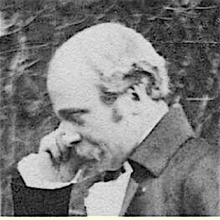
George Gilbert Scott, Jnr. [also known as George Gilbert Scott, the Younger] was born in London, England on 8 October 1839. From 1857 to 1860 he was articled to his father, the architect Sir George Gilbert Scott (1811-1878), and then worked as his assistant. From 1863 to 1866 he studied moral sciences at Jesus College, Cambridge. During the 1860s he worked with his father on various architectural projects, whilst undertaking research at Cambridge. In the early 1870s he established his own architectural office at 7 Duke Street, London. He soon established a reputation as an an architect of ecclesiastical buildings.
In addition to his work as an architect, Scott also designed wallpaper and furniture and, with fellow architects George Frederick Bodley (1827-1907) and Thomas Garner (1839-1906), set up the firm of Watts & Co. c.1874 to produce their own designs.
He exhibited on nine occasions at the Royal Academy in London from 1871 to 1884. An illustration of the interior of St. Agnes, Kennington Park, designed by Scott was shown in the 3rd exhibition of the Arts & Crafts Exhibition Society at the New Gallery in London in 1890,
Scott's address was given as 24 Essex Street, London in 1871; 31 Spring Gardens, London in 1872; 7 Duke Street, Portland Place, London in 1873 and 1875; 31 Spring Gardens, London in 1879 and 1883; and 26 Church Row, Hampstead, London in 1884.
His later career was marred by alcoholism and mental instability. He died on 6 May 1897, while a permanent resident in the Midland Grand Hotel, St Pancras, a building designed by his father.
The papers of George Gilbert Scott, Jnr. are held at the Royal Institute of British Architects Library, London
"His masterpiece was undoubtedly" [Curl] the Church, School and Vicarage of St. Agnes, Kensington Park, London (1874-91), which has since been destroyed. Notable among other churches by him were St. Mark. in New Milverton, Leamington Spa, Warwickshire (1876-79), All Hallows, Southwark, London (1879-92), St. Mary Magdalene in East Morks, Yorkshire (1879-82); and St John the Baptist Church in Norwich, Norfolk (1884-1910, continued by his brother, John Oldrid Scott). Other projects included the remodelling and redecoration of Peterhouse Hall, Cambridge (1870); St. Mark's Vcarage, Leamington, Warwickshire (1875); Recory, Woolton Hall, Hampshire (1875-77); 3 and 5 Salisbury Street, Hull, Yorkshire (1877-79); and New Building, Pembroke College, Cambridge (1879).
Church Art. [Catalogue of an exhibition at the Victoria & Albert Museum, London, 1971-72]. London: Her Majesty’s Stationery Office, 1971 pp. 137-138
Curl, James Stevens. Dictionary of Architecture. Oxford: Oxford University Press, 3rd edition, 2015
Directory of British Architects 1834-1914. Compiled by Antonia Brodie, et al. Volume 2: L-Z. London; New York: British Architectural Library, Royal Institute of British Architects/Continuum, 2001
Hamilton, Alec. Arts & Crafts Churches. London: Lund Humphries, 2020
Millard, W. ‘Notes on some works of the late Geo. Gilbert Scott, M.A., F.S.A. - Gilbert Scott the Younger’. Architectural Review vol. 5, 1898-99 pp. 59-66, 124-127
Stamp, Gavin. An Architect of Promise: George Gilbert Scott junior (1839-1897) and the Late Gothic Revival. Donnington: Schaun Tyas, 2002
Stamp, Gavin. The English House 1860-1914. Catalogue of an exhibition of photographs and drawings. London: InternationalArchitect and the Building Centre Trust, 1980 p. 18
Stamp, Gavin. ‘The lost hope of late Victorian architecture: George Gilbert Scott Junior’. Victorian no. 9, March 2002, pp. 4-8.
Stamp, Gavin. ‘Ramsgate Cemetery Chapel’. [Designed by George Gilbert Scott, Jnr., 1869-71]. Architectural History vol. 41, 1998, pp. 273-277.